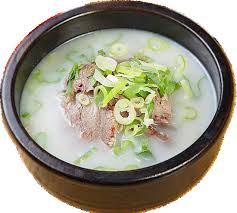It seems there are two kinds of Korean soups. Some of them are '국', such as 미역국, 콩나물국, 배추국. But then there are also '탕', such as 갈비탕, 삼계탕. Some even seem to have two names, e.g., '우거지국' & '우거지탕'. What is the difference between '국' and '탕'?
-
1Here's a hypothesis. A soup that is considered 반찬 (side dish to 밥) is 국; a soup not considered 반찬 is 탕. One way to try to confirm it would be too see whether 탕 are generally more substantial than 국.– CatomicCommented Feb 9, 2017 at 6:14
-
@Catomic: 돼지국밥 is a famous dish from Busan: it is a soup (국) containing pork (돼지) and rice (밥) as main ingredients. It is similar to 설렁탕(!), except the latter is made with ox meat and is more a Seoul dish.– TaladrisCommented Feb 9, 2017 at 7:28
2 Answers
They are similar dishes. For example, here are pictures of two Korean dishes:
- 돼지국밥 is probably the most famous dish from Busan: it is a soup (국) containing pork (돼지) and rice (밥) as main ingredients.

- 돼지국밥 is similar to 설렁탕, except that the latter is made with ox meat and is a Seoul dish.

Honestly, I can barely see a difference from the pictures.
The 탕(Tang) page on Wikipedia redirects to the 국(Guk) page. According to that page,
Guk(국), also sometimes known as Tang (탕), is a class of soup-like dishes in Korean cuisine. Guk and tang are commonly grouped together and regarded as the same type of dish, although guk is more watery and a basic dish for the Korean table setting, and is usually eaten at home; tang has less water than guk and has been developed for sale in restaurants.
There is more information on the Wikipedia page:
- As often in Korean, one word has a native Korean origin (국) while the other has a Sino-Korean origin (탕). 탕 (as many Sino-Korean word I think) has been used as a honorific form of 국.
- Some dishes seem to be known with two names, like 곰국/곰탕, but 국 and 탕 are not interchangeable. In particular, 감자국 is made from potatoes (감자) while 감자탕 contains pork bones and potatoes.
Note: The Korean Wikipedia seems to confirm the English version: the dis-ambiguity page for 탕 describes it as "국의 높임말" ("국's honorific form") and the 국 page has "국또는 탕은 밥과 함께 먹는 국물 요리" ("Tang, as well as Guk, is a soup eaten together with food") for first sentence.
-
Please feel free to correct my approximative translation of the Korean Wikipedia in the note.– TaladrisCommented Feb 9, 2017 at 7:53
-
I am not wedded to my hypothesis, but one may argue that 돼지국밥 was not a counterexample, but rather a confirmation, by noting the presence of 밥 in it. The thing is a meal in itself--the argument goes--and too substantial to be called 국; hence 국+밥, a grander appellation than even 탕. / Another datum may be there being no 탕 made wholly of vegetables, if that is the case.– CatomicCommented Feb 9, 2017 at 8:10
-
AFAIK, 국밥 is not a honorific for 국, but simply means "rice inside the soup".– TaladrisCommented Feb 9, 2017 at 8:32
-
Not suggesting that it was. / I find strange the whole idea of 탕 being an 'honorific' for 국 (as found in the article you link). For x to be an 'honorific' of y, they should have the same meaning (denotation) but respective usages that are subject to social considerations. For example, '진지' is an honorific for '밥' because you say '진지 드세요' to an elder and '밥 먹어라' to a child (and mean the same thing). No such relationship exists between any 'N국' and 'N탕' pairing.– CatomicCommented Feb 9, 2017 at 8:45
-
If we got all things that are called either 국, 국밥, or 탕 and lined them up in order of substance, viz. whether it alone could serve as a meal, the modified hypothesis (to account for 국밥) would predict that 국 would be on one side and 국밥 and 탕 on the opposite, with some area of 'fading in' in the middle. If the prediction came true, an explanatory theory might suggest that the 밥 element in 국밥 is the 'substance bearer' as it were, as 국 certainly isn't (from its distribution to the wrong side).--All this is meant to be funny if that didn't come through.– CatomicCommented Feb 9, 2017 at 8:57
국 and 탕 more or less mean the same, 탕 being the honorific form. 탕 isn't used as commonly as 국 though.
For example
나머지는 내가 준비할 테니 가서 탕을 좀 내와라.
means the same as
나머지는 내가 준비할 테니 가서 국을 좀 내와라.
However when they are used to incidate specific dishes, they do have a slight difference in meaning. According to 표준국어대사전, the suffix -탕 is used to mean 국 which has a rich taste due to being cooked for a long time. That makes sense since most dishes with 탕 at the end of their names are made with different kinds of meat, and cooked for a long time to enrich their tastes.
-
I've upvoted this for "cooked for long time." (I don't know why anybody would have downvoted it since no explanation was given.)– CatomicCommented Feb 9, 2017 at 14:18